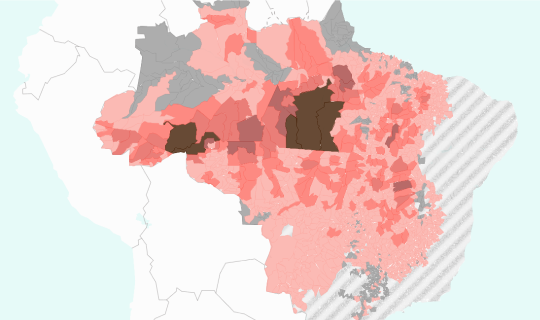Chocolate is eating West African forests, driving up emissions
Also in:
FrançaisCocoa is the main driver of deforestation in Côte d’Ivoire, the world’s biggest cocoa producer, according to new data released today. Forests and land use are central to achieving the Paris Agreement targets under discussion at COP27.
Oxford, United Kingdom (10 November 2022) — New data released today by transparency initiative Trase[1] reveals that cocoa farming swallowed 2.4 million ha of forest in Côte d’Ivoire between 2000 and 2019, an area almost the size of Rwanda. This represents 45% of the total deforestation and forest degradation in the country.
In 2019, 25% of cocoa areas were found in protected forests, reflecting weak enforcement of legal protections for these lands.
“Cocoa supply chains are highly exposed to deforestation, including illegal deforestation,” said Cécile Renier, a researcher at UCLouvain, who led the Trase study.
Two-thirds of Côte d’Ivoire’s cocoa is exported to the EU and the UK. The EU is currently finalising legislation which would mandate scrutiny of cocoa imports for links to deforestation.
In 2019, the exporters whose supply chains were exposed to the most deforestation[2] were Cargill, Olam, Barry Callebaut and Touton.
The data also reveals very limited transparency in supply chains, even though companies in the Cocoa & Forests Initiative (CFI)[3] say they have mapped over 70% of their direct supplies.
“Direct supplies are only a fraction of the story,” Renier said. “Traders buy substantial volumes - sometimes most of their cocoa - from intermediaries, without knowing who those intermediaries source from. In fact, Cocoa & Forests Initiative traders mapped only 22% of national cocoa exports in 2019, and from their latest report, the situation has not evolved much since.”
Trase researchers say that joint efforts between companies, governments and communities are needed. To halt cocoa-driven forest loss, companies must go beyond the traceability of their own individual supply chains to invest in initiatives at the landscape level.
“The sector could finance staffing and equipment for forest monitoring and protection efforts across cocoa-growing regions,” Renier added.
Forests and land use are central to achieving targets under the Paris Agreement, which world leaders are discussing at COP27, which has just begun in Egypt.
“The threat posed by agriculture to African forests has been poorly studied compared to soy and beef in Latin America and palm oil in Indonesia,” said Dr Toby Gardner, Trase Director at the Stockholm Environment Institute.
“As Africa’s COP unfolds, the world needs to hear the less-than-sweet news - chocolate is eating West African forests, driving up emissions.”
For further information, contact: media@trase.earth
Notes for Editors
[1] From 10 November 2022, the data will be available on the Trase website (www.trase.earth).
Founded by Global Canopy and the Stockholm Environment Institute, Trase is a data-driven transparency initiative and global partnership that maps the international trade and financing of agricultural commodities, providing tools that enable companies, financial institutions and governments to address tropical deforestation.
[2] Deforestation exposure is a metric describing past deforestation embedded in the trade of cocoa.
It is calculated through a retrospective approach that aggregates past deforestation within the footprint of currently productive cocoa plantations. More information on the methods for calculating this is available on request.
[3] The Cocoa & Forests Initiative (CFI) is a partnership with 35 companies and the governments of Côte d’Ivoire and Ghana.




